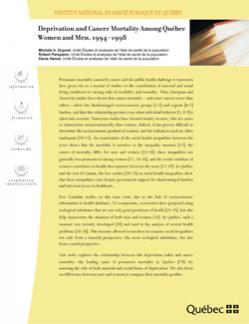Premature mortality caused by cancer and the public health challenge it represents have given rise to a myriad of studies on the contribution of material and social living conditions to varying risks of morbidity and mortality. Thus, European and American
Premature mortality caused by cancer and the public health challenge it represents have given rise to a myriad of studies on the contribution of material and social living conditions to varying risks of morbidity and mortality. Thus, European and American studies have shown that cancer mortality—and some cancers more than others—often hits disadvantaged socioeconomic groups and regions hardest, and that this relationship persists even when individual behavior is taken into account. Numerous studies have focused mainly on men, who are easier to characterize socioeconomically than women. Indeed, it has proven difficult to determine the socioeconomic position of women, and the indicators used are often inadequate. An examination of the social health inequalities between the sexes shows that the mortality is sensitive to the inequality measure, the causes of mortality differ for men and women, these inequalities are generally less pronounced among women, and the social condition of women contributes to health discrepancies between the sexes. In Québec and the rest of Canada, the few studies on social health inequalities show that these inequalities exist despite government support for disadvantaged families and universal access to healthcare.
Our results corroborate the conclusions of the international literature: In Québec and elsewhere, those from disadvantaged environments are more likely to die prematurely from cancer. Our findings also show that male and female mortality profiles converge for stomach, pancreatic, and bladder cancers, but diverge for other cancers found in both sexes. In addition, the socioeconomic gap among women of various quintiles is smaller than it is in men. Material and social deprivation also has less of an impact on female mortality than on male mortality. For total cancer mortality, the combination of both social and material deprivation increases the risk of mortality in the most disadvantaged men and women. However, male mortality is around 20% higher than female mortality. This difference between the sexes is similar to that found in Great Britain and the United States.


